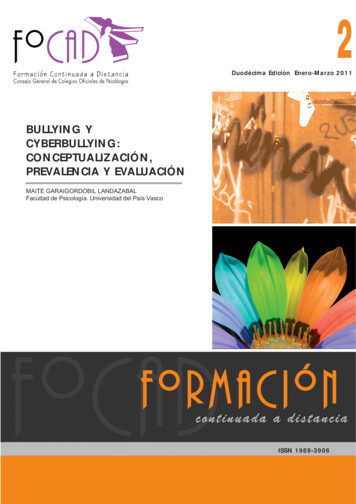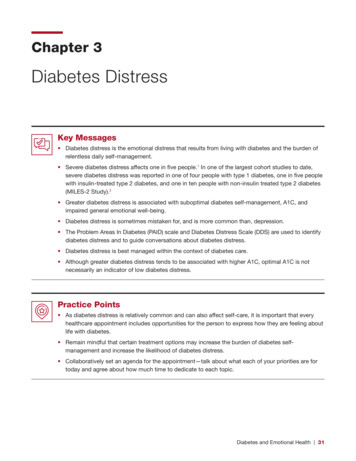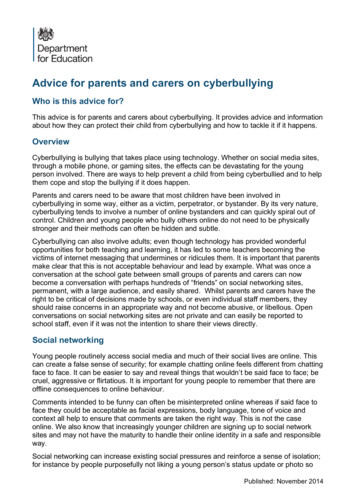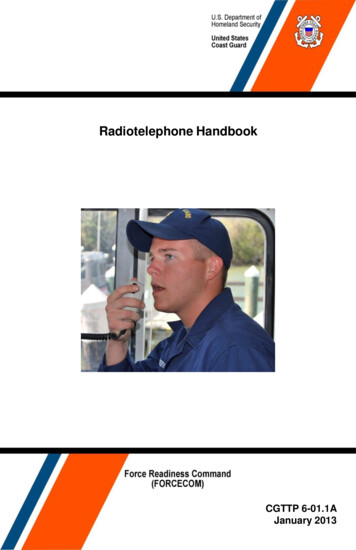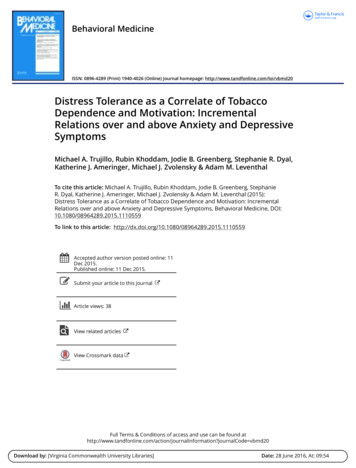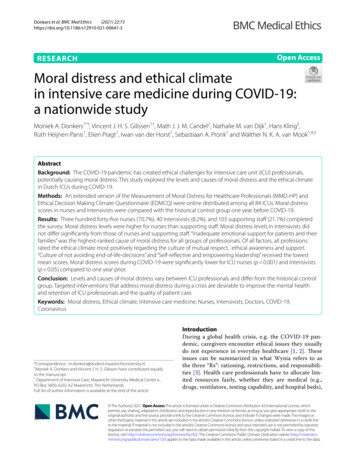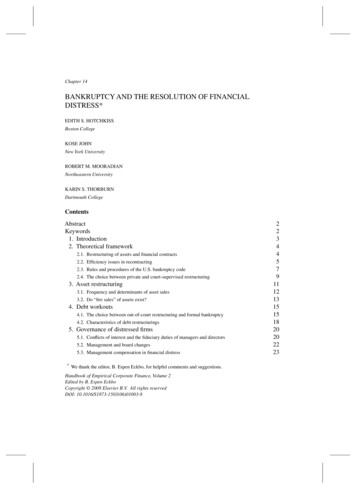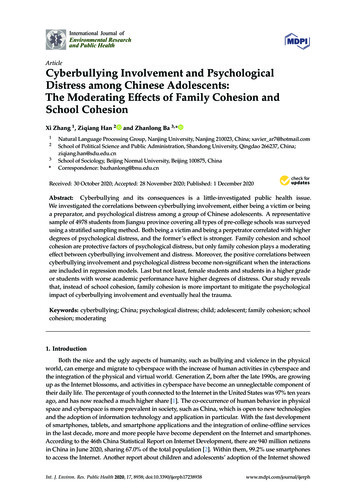
Transcription
International Journal ofEnvironmental Researchand Public HealthArticleCyberbullying Involvement and PsychologicalDistress among Chinese Adolescents:The Moderating Effects of Family Cohesion andSchool CohesionXi Zhang 1 , Ziqiang Han 2123*and Zhanlong Ba 3, *Natural Language Processing Group, Nanjing University, Nanjing 210023, China; xavier ar7@hotmail.comSchool of Political Science and Public Administration, Shandong University, Qingdao 266237, China;ziqiang.han@sdu.edu.cnSchool of Sociology, Beijing Normal University, Beijing 100875, ChinaCorrespondence: bazhanlong@bnu.edu.cnReceived: 30 October 2020; Accepted: 28 November 2020; Published: 1 December 2020 Abstract: Cyberbullying and its consequences is a little-investigated public health issue.We investigated the correlations between cyberbullying involvement, either being a victim or beinga preparator, and psychological distress among a group of Chinese adolescents. A representativesample of 4978 students from Jiangsu province covering all types of pre-college schools was surveyedusing a stratified sampling method. Both being a victim and being a perpetrator correlated with higherdegrees of psychological distress, and the former’s effect is stronger. Family cohesion and schoolcohesion are protective factors of psychological distress, but only family cohesion plays a moderatingeffect between cyberbullying involvement and distress. Moreover, the positive correlations betweencyberbullying involvement and psychological distress become non-significant when the interactionsare included in regression models. Last but not least, female students and students in a higher gradeor students with worse academic performance have higher degrees of distress. Our study revealsthat, instead of school cohesion, family cohesion is more important to mitigate the psychologicalimpact of cyberbullying involvement and eventually heal the trauma.Keywords: cyberbullying; China; psychological distress; child; adolescent; family cohesion; schoolcohesion; moderating1. IntroductionBoth the nice and the ugly aspects of humanity, such as bullying and violence in the physicalworld, can emerge and migrate to cyberspace with the increase of human activities in cyberspace andthe integration of the physical and virtual world. Generation Z, born after the late 1990s, are growingup as the Internet blossoms, and activities in cyberspace have become an unneglectable component oftheir daily life. The percentage of youth connected to the Internet in the United States was 97% ten yearsago, and has now reached a much higher share [1]. The co-occurrence of human behavior in physicalspace and cyberspace is more prevalent in society, such as China, which is open to new technologiesand the adoption of information technology and application in particular. With the fast developmentof smartphones, tablets, and smartphone applications and the integration of online-offline servicesin the last decade, more and more people have become dependent on the Internet and smartphones.According to the 46th China Statistical Report on Internet Development, there are 940 million netizensin China in June 2020, sharing 67.0% of the total population [2]. Within them, 99.2% use smartphonesto access the Internet. Another report about children and adolescents’ adoption of the Internet showedInt. J. Environ. Res. Public Health 2020, 17, 8938; rph
Int. J. Environ. Res. Public Health 2020, 17, 89382 of 11that 99.2% of the Chinese children and adolescents have experience of accessing the Internet in 2020,and 78% of the youth started to use internet service under the age of 10 [3]. The vast and deepintegration of virtual and physical life, such as online shopping, digital payment, online gaming, onlinesocialization, online study, etc., has made human activities in cyberspace much more prevalent thanever, and this trend will keep continuing in the predictable future.Cyberbullying is becoming more common with children and adolescents’ increasing activitiesin cyberspace [4]. It refers to acts intended to harm others who cannot defend themselves usinginformation communication technologies (ICTs) or in cyberspace [5,6]. Generally, there are two types ofcyberbullying assessment instruments [7–9]. The first type usually describes or defines cyberbullyingfirst and then asks the respondents to rate the prevalence or frequency of cyberbullying involvement.The other kind usually inquires about the occurrence of concrete cyberbullying behaviors, such asverbal or relational bullying in cyberspace. The prevalence of cyberbullying perpetration, victimization,and their overlap varies in different countries and research contexts, and there has been an increasingtrend in recent years [10]. A recent review found that Canada and China have a higher prevalence ofcyberbullying from the victim’s perspective, while Australia, Sweden, and Germany have a relativelylower occurrence rate compared with other countries included in the survey. The median prevalencesin these countries from the studies included in this review were 23.8% (Canada), 23.0% (China),5.0% (Australia), 5.2% (Sweden), and 6.3% (Germany) [10], while the prevalence of being a perpetrator,a victim or both in the United States ranged from 1% to 41%, 3% to 72%, and 2.3% to 16.7%,respectively [11]. Cultural differences and Internet accessibility are the possible reasons for such adifference across these countries [10]. This review also showed a lack of cyberbullying studies fromChina, a similar observation from another school bullying review in 2010 [12]. Thus, more studies oncyberbullying in China should be conducted.Cyberbullying experience can cause various mental health, social-psychological, and behavioralproblems, such as emotional and psychological distress, social anxiety [13], aggression and hostility [14],fear, depression, hyperactivity disorder, substance use [13], self-harm [15], and even suicidal ideationand attempts [13–16]. As the early stage of the consequence of cyberbullying involvement, psychologicaldistress can lead to other severe mental health and behavior problems, such as suicide [17]. Prior studiesindicated that cyberbullying’s indirect effect on suicidal ideation through psychological adjustmentwas actually more massive than cyberbullying’s direct effect [18]. Moreover, a study from Canadaindicated that the cyberbullying victimization experience predicted psychological distress and lowself-esteem over other bullying forms in schools [19]. Meanwhile, cyberbullying perpetration is notonly correlated with psychological difficulties and lower quality of life [20] but is also associatedwith external problematic behaviors over time [21]. Therefore, it is essential to investigate the impactmechanisms between cyberbullying involvement and psychological distress and protective factors.There are generally two groups of moderators between cyberbullying experience and thesocial-psychological consequences: the contextual factors, such as school climate, family relationship,and individual factors, such as gender, age, and sexual orientation [14]. Investigating the contextualfactors is crucial because they are changeable and can provide scientific lessons and solutions for furtherinterventions. A prior study indicated that social support from family, teachers, and friends couldreduce the negative psychosocial symptoms while increasing the well-being of cyberbullying-involvedstudents [22]. Moreover, school and family are the two micro-social environments that studentsinteracted with in daily life, and, thus, we included the school and family factors as the moderatingfactors in this analysis with a firm purpose of intervention in the future.Based on the reviews about the prevalence of cyberbullying, the associations of cyberbullyinginvolvement and the social-psychological consequences, and the roles of family cohesion and schoolcohesion, we found a knowledge gap in the correlations between cyberbullying involvement and itspsychological consequences. Therefore, we analyzed a recently collected representative database fromJiangsu province in China with the purpose of investigating the correlations between cyberbullying
Int. J. Environ. Res. Public Health 2020, 17, 89383 of 11involvement and one of the most common mental health issues—psychological distress—with a focuson the mitigating effects of family cohesion and school cohesion. We assumed that:Hypothesis 1a (H1a). Being a cyberbullying victim is correlated with a higher degree of psychological distress.Hypothesis 1b (H1b). Being a cyberbullying perpetrator is also correlated with a higher degree of psychological distress.Hypothesis 2a (H2a). Family cohesion can mitigate the impact of cyberbullying victimization on psychological distress.Hypothesis 2b (H2b). Family cohesion can mitigate the impact of cyberbullying perpetration on psychological distress.Hypothesis 3a (H3a). School cohesion can reduce the impact of cyberbullying victimization on psychological distress.Hypothesis 3b (H3b). School cohesion can reduce the impact of cyberbullying perpetration on psychological distress.2. Methods2.1. Participants and SamplingFour thousand nine hundred seventy-eight (4978) adolescents from Jiangsu province, China,participated in this study between December 2019 and January 2020. A stratified sampling methodwas adopted in this survey. We first divided Jiangsu providence geographically into the north, centraland south parts. The geographical variance also represents the economic differences within theprovince. One rural county and one urban county/district were randomly selected within each ofthe three geographical areas. One primary school, one middle school, and one high school wererandomly selected within each county. Only students from grades four to six within the primaryschools participated in the survey because we assumed that the youngers might be too young tounderstand our questions. Thus, children from grade four to grade six in primary schools, students ofall grades in middle school and high school participated in the survey, representing the adolescentswithin Jiangsu province.The survey was conducted through computer-assisted solutions. We developed and distributedour questionnaire through an online survey platform, WJX (www.wjx.cn). Working closely with thelocal education administrative agencies and the schools, a link to our online questionnaire surveywas distributed to the qualified candidates. The students can finish the self-reported survey eitherthrough a computer or smartphone, or electronic tablets. Students from the selected schools finishedthe survey using computers or tablets during their IT (information and technology) class in most of theparticipated schools. The first page of the questionnaire was displayed, and a student can finish itvoluntarily and anonymously, and they can quit the survey at any time if they do not like it. The ethicalresearch committee of Sichuan University approved the IRB (K2019067, 12 November 2019) for all datacollection efforts targeting both parents, teachers, and students, and we only used the children’s datain this paper.2.2. MeasuresPsychological distress: The psychological distress scale from the Psychological Well-Being andDistress Screener (PWDS) [23] was used to measure adolescents’ mental health status. The PWDS isa 10-item scale consisting of two five-item subscales, namely the psychological well-being scale andpsychological distress scale. The PWDS was developed from prior measures of adolescents’ mentalhealth status in a large cross-countries study, the Health Behavior in School-Aged Children (HBSC),organized by the World Health Organization (WHO). The PWDS was initially tested in the UnitedStates by a sample of youth in Grades 5 to 10 [23] and later expanded to other cultures, such as theChinese [24]. The psychosocial distress scale consists of five items, inquiring about a respondent’sfeelings of psychological distress. The inquiries were, “Thinking about your last week, have you felt
standarddeviation of 4.35(Table 1). the students’ involvement in four types of bullying behaviors inThe cyberbullyinginvestigatedInt. J. Environ. Res. Public Health 2020, 17, x FOR PEER REVIEW4 of 11Thecyberbullyinginvestigatedinvolvementin four typesbullyingbehaviorsincyberspace, based on measures usedthein students’the SchoolCrime Supplement(SCS)ofofthe NationalCrimewas 0.8987, indicating very good internal consistency. The aggregation of the five items’ scores EVIEWcyberspace,basedon measuresused in(SCS)forof theNationalCrime 4 of 11VictimizationSurvey[25] entNational CenterEducationStatisticsindicatingvery goodinternalconsistency.of valuethe fivewasused aswasthe 0.8987,psychologicaldistressdegree,rangingfrom 5 toThe25, aggregationwith a meanof items’11 andscoresaVictimizationSurvey[25]developedby onethe was,UnitedStates’ NationalCenterfor Educationand in our priorstudies[26–29].The first“insulatingor laughingor mockingothersStatisticsthroughusedas thedegree,rangingfrom 5 Theto 25,with a meanvalueof11 anda wasstandarddeviationofpsychological4.35 (Table egationof theitems’scoresandin ourwaspriorstudies[26–29]. Thefirstonewas,“insulatingor laughingormockingothersthrougha mobilephoneor in indicatingcyberspace,includingtheWechat,Tik nInt. J.TheEnviron.Res.PublicHealth2020,17,89384of11used asororthepsychologicaldistressdegree,from5 to 25,witha meanvalueof 11 and aamediamobilephonein apps.”cyberspace,includingtheWechat,Tik Tok,TencentQQ,Weibo,or informationothersocialplatformsThe veThecyberbullyinginvestigatedstudents’four oftypesbullyingCrimebehaviors incyberspace, basedon measuresusedin (Tablethe theSchoolCrimeinvolvementSupplementin(SCS)the or theapps.”behaviorother’swas “spreadingrumorsnegativeinformationabout others,”whilethirdTheonesecondwas “violatingprivacy edonmeasuresin theSchoolCrimeSupplement(SCS)of usedthe UnitedStates’NationalCenter viorsinaboutothers,”whileyouthethirdonewas ’spersonalinformation,photosor hadvideosonline.”Thelast“sad”one andwas“Excludingortheisolatingothersinonline. . . ?”oftenhavethefollowing. . tionalCenterforEducationStatisticsandin s tingothersin onlinegamesor“feelingothersocialin ywhilelow,”“feelingand“feelingirritabilityor laughingbadtemper”wasthe thersaweek,mobilephoneor priorin cyberspace,includingtheWechat,TikTok, TencentQQ,Weibo,or onwasobtainedbythe lastquestion“Have anyofyour classmatesoreachpeersofengagedin thefollowingbehaviorsto youin last Statisticsfor thesix months.Theanswersevaluatingthe feelingswere“Never(1)”,“Rarely(2)”,a tudies[26–29].Theonewas,“insulatingor laughingorothersthequestionanyyourclassmatesor firstpeersengagedin“havethe followingbehaviorsto youinlast rsonalatomobilephoneororclassmatesin eibo,or other socialyear?”whilethe thefollowingbehaviorsyourin achof thefourbehaviorsexhibitedgoodmeasurementandwitha nformationbehaviorstoyourpeersor classmatesin last[24].year?”.Theoriginalanswerseach resultof the ,”“sometimes,”and“often,”and thetoalpha“sometimes”and“often”0.760inora ethe thirdwas “violatingother’sprivacyby postingother’s ometimes,”and while“often,”andthe recodedas one(involvedinonecyberbullying)“never”and eswasusedasthewere nyof as oneranging(involvedin 5cyberbullying)whilethe “never”and“rarely”choices[30].werecoded aswerezero(notdegree,involvedin cyberbullying)duetoatherepetitivenessdefinitionof bullyingIfin meanvalueof11anda standarddeviationthe owingor involvedother socialinteractionsin duecyberspace.”The cyberbullyingvictimizationwasbycodedas gameszero(notincyberbullying)to the repetitivenessdefinitionof iencedanyof the four cyberbullyingbehaviorsproposed,heorwas definedof o rstoyouinlastonerespondentexperiencedany theoforthefour cyberbullyingbehaviorsproposed,he or behaviorsshe7.49%was definedasbeinga andfourthetypesofthebullyingin thebehaviorsto yourpeersclassmatesin wersto ,”“sometimes”andyear?”whilethe berbullying)the“sometimes,”School sometimes”and“often”choiceswere �rarely”choiceswerebehaviorsto your peersor classmatesin last year?”.The originalanswers to eachof the four VictimizationSurvey[25]1).developedby the vedin“never,”cyberbullying)tothe repetitivenessofthebullying[30].If . TheThe studiesschoolcohesionwasmeasuredbytwo items,while threeitems capturedthe eriencedzero were(not involvedincyberbullying)duebehaviorsto the repetitivenessdefinitionof “rarely”bullying[30]. If wereone respondentany ofasthefourcyberbullyingproposed,heor she andwasdefined �never”Theschoolwasmeasuredbytwo were ionsaboutschoola mobileoritemsin cohesioncyberspace,includingWechat,Tik he fourcyberbullyingproposed,heor elationshipwith [30]. erespondentexperiencedany ofwiththe fourcyberbullyingproposed,heor onshipyourteacher?”andbehaviors“howis etrator.Withinthe“howsample,7.49% of theyourclassmates?”the(5)”.answersfromonefive, representingthemeaningsfrombad (1)”to being“veryThe rangedthreelaststatementsaboutfamilyor cohesionwereis suredTheby twooneitems,threeitemscapturedthein dparents?”,(5)”. owisbyyourrelationshipwith interactionsyour“dolike nedTheschoolbytwoitems, Thewhilethreeitemscapturedthe familycohesionswere ”and“howwhileis ms,threeitemscapturedand“docyberbullyingyoulike tostaywithfamily?”.TheThesumoftheitems the2last viorsto “veryyour peersor(5)”.classmatesin laststatementsyear?”. fromTheaboutoriginalanswersto eachwereof thethe“howfour behaviorsclassmates?”andtherangedone tofive,representingmeaningsfrom “very nis her?”andtest“howis ueof ten,”and“sometimes”and“often”bad amilycohesionwere“howis fromyour tes?”andfromtherangedfromone to andfive,0.7789,representingthe ofmeaningswas12.82asonaverage,3answersto 15 ourfamily?”.Thesumoftheitemswithineachcategoryto “verygoodcohesion(5)”. Thethree statementsaboutfamilyrespectively,cohesion were“howis yourcohesionindicatorandtheofschoolindicatorwere 0.8352and eitemswithineachcategorywas usedto ts?”,“do youlikeandto academicshare yourthoughts andfeelingswith de,whetherbeingina periencedanyof thefourcyberbullyingbehaviorsheor shewasdefinedas from to10, de,whetherbeingin students,a boardingschool,academicperformancewereincludedas eboys,23.89%ofthemliving in petrator.Withinthesample,7.49%ofofthestudentsto10, average,withuseda meanvalueof school8.46a standarddeviationof1.41,whilethe familycohesiondegreefrom 2was12.82onrangingfrom3 to ,978students,51.45%ofthemwere cyberbullyingboys,23.89% 3 to15 a(TableTheCronbach’salphatesttheresultsof cohesionthe onindicatorwere amilyschoolduringweekdays,fromoneto five(Table 1).and with an average self-evaluated academic performance of 3.40 hoolcohesionwereand sistencyboth12.82onofaverage,rangingfrom 3indicatorto 15 (Table1).0.8352The Cronbach’stest resultsof the familyfrom one wasto five(Table1).good hetherbeinga boardingschool,indicatorand ,indicatingTable1. Descriptiveanalysis 4978).Table1. Descriptiveanalysis(N ,andacademicperformancewereincludedas control oys,23.89%ofthemlivingingood internal consistencyof 1.bothmeasures.TableDescriptiveanalysis (N 4978).VariablesFrequency/Mean(SD)as 45%academicofthemwereboys,Percent/Range23.89%them werelivingincludedinschool der,andgrade,beingin Frequency/Meana withthean 4,978averageself-evaluatedacademicperformanceof 3.40rangingfrom oneto ables.variableWithinstudents,51.45% ofthem wereboys, 23.89%of themliving inPsychologicaldistress11 (4.35)5–25Dependentvariablefrom �25school Table1. Descriptive analysis (N zation(yes 1) ※3737.49IndependentvariablesCyberbullying victimization (yes 1)373 (N 4978).7.49Table1. ※Descriptive ation102(SD)2.05Cyberbullyingperpetration (yes(yes 1)1) ※※ Frequency/Mean102 ptiveanalysis(N Percent/RangeFamilycohesion amilycohesion (yes 1) ※12.82 (2.24)3–15Psycholog
1 Natural Language Processing Group, Nanjing University, Nanjing 210023, China; xavier_ar7@hotmail.com 2 School of Political Science and Public Administration, Shandong University, Qingdao 266237, China; ziqiang.han@sdu.edu.cn 3 School of Sociology, Beijing Normal University, Beijing 100875, China * Correspondence: bazhanlong@bnu.edu.cn
